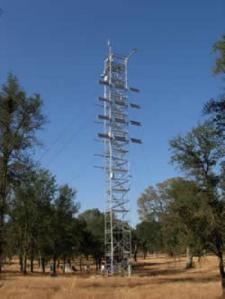
By comparing forest temperature measurements from Fluxnet towers, like this one in Tonzi Ranch, California (not actually used in this study), with nearby weather stations in grassy fields, Xuhei Lee and his colleagues could determine the warming or cooling effect of forests. Credit: Dennis Baldocchi
Trees growing near the equator can directly cool local temperatures, while those nearer the poles can have a direct warming effect. That’s according to a team of 21 scientists from Germany, Canada and the US who have compared temperatures in North American forests with those in nearby open areas. Snow covered open land reflects sunlight back into space in the day, and cools further at night. Trees in such environments, meanwhile, absorb light in daytime and help trap heat near the ground at night. By contrast, in warmer areas, trees’ large, rough, surface area releases heat into the atmosphere more efficiently than open land. This direct effect operates separately to the role trees play in climate by absorbing CO2, but does contribute to their overall influence on world temperatures.
“It reinforces the notion that the benefit of tree planting depends on where you do it,” lead scientist Xuhui Lee from Yale University told Simple Climate. “Our data suggest that planting is beneficial south of 35 degrees north [the distance between the North Pole and North Africa, North Carolina or Tibet] and may be counterproductive north of that.” Another implication comes because weather stations are supposed to be located away from objects like buildings and trees that absorb and release heat. Consequently, the same effect could also influence global temperature records that we rely on to monitor climate change like the one produced by NASA’s Goddard Institute for Space Studies. Lee said that though this might affect some local measurements, the overall historical records should be correct. He is more worried by what locating weather stations only outside forests does to the measured difference between the daily maximum and minimum temperature, known as the diurnal temperature range or DTR. “Our results show that DTR could be off by as much as 8ºC in some locations,” Lee said. Read the rest of this entry »

